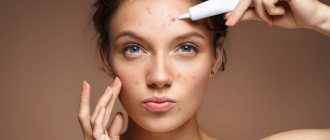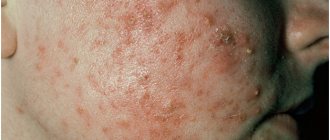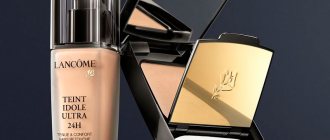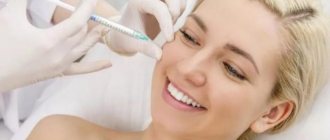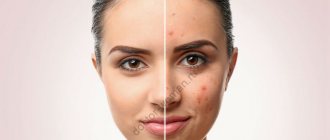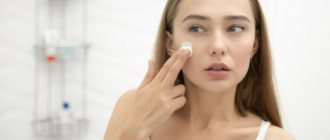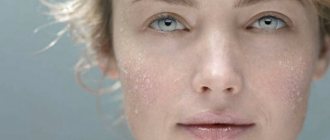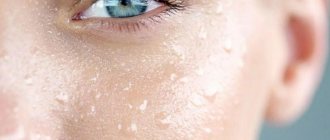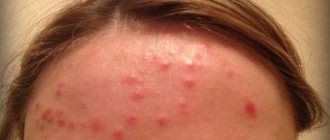Problematic facial skin: causes
The content of the article
Various factors can negatively affect the health of the skin. Especially often these are pathologies of internal organs, infection with fungus, herpes, staphylococcus, and the attachment of ticks. Under the influence of external factors (stress, poor diet, smoking, solar radiation) the protective function of tissues also decreases. This often manifests itself as cosmetic defects in the facial area.
To effectively deal with the problem of skin rashes, you need to establish the cause of the unpleasant symptoms. In adolescence, imperfections in the form of acne, greasiness or dryness in 90% of cases are associated with the characteristics of puberty. But after 20 years, rashes are a clear sign of health problems.
The following pathologies lead to the appearance of rashes:
- Hormonal disbalance
. In particular, excessive acne is observed with elevated testosterone levels. Acne in women can appear during certain phases of the menstrual cycle. For example, a few days before your period. - Weakening of the immune system
. Junk food, UV radiation, abuse of alcohol, tobacco, and cosmetics reduce the protective ability of Langerhans cells. - Disorders of the gastrointestinal tract.
Digestive disorders are accompanied by intoxication of the body, which is associated with stagnation of food in the stomach. Toxins accumulate in cells and are eliminated through the skin. When removing toxins, the ducts of the sebaceous glands become clogged, which causes inflammation. - Allergy
. This is a hypersensitivity reaction to an irritant, which manifests itself in rashes of various types. - Genetic predisposition
. Problems with hormones, the functioning of the sebaceous glands, and the toxic composition of sebum are often inherited.
Enlarged pores
They are expanded recesses of the skin, which are the mouths of the hair follicles and at the same time openings for removing the secretions of the sweat and sebaceous glands. Pores become visible to the eye with a diameter of 250–500 microns or more.
The main cause of enlarged pores is sagging skin. As we age, the main connective tissue proteins (collagen and elastin) begin to degrade, causing the skin to gradually sag and pores to enlarge. Excessive synthesis of sebum plays a certain role, which accumulates in the pores along with horny scales and dirt particles, causing them to swell and become visible. One of the reasons for enlarged pores is the “love of peelings.” Repeated application of chemical peels is accompanied by an inflammatory reaction that does not have time to subside, leading to changes in the dermal layer of the skin and enlargement of pores.
Enlarged pores appear as visible crater-shaped depressions on the skin, round or irregular in shape ( Fig. 9 ). There is a tendency for their number to decrease with age.
Find out more about enlarged pores and how to correct them here.
Rice. 9. Enlarged pores on the cheeks and nose (Only m health)
Signs of skin problems
Treatment of facial skin is necessary when the following symptoms appear:
- constant formation of inflammatory foci - acne, pimples, comedones;
- fat content of the upper layer of the epidermis;
- peeling of the skin on the face in men and women;
- age spots, freckles;
- hyperemia of the skin;
- itching and redness;
- blackheads, enlarged pores.
Freckles
Dark spots
Treatment of facial skin for acne and other cosmetic defects is a long process. Cosmetic procedures often turn out to be ineffective. Therefore, at the first signs of pathology, you should consult a doctor. The doctor will help determine the cause of the rash and select effective treatment methods.
Wrinkles around the eyes
This is a clear sign of aging of the facial skin around the eyes of varying degrees of severity - from fine lines to large creases. Their main causes are chrono- and photoaging. A significant aggravating factor is smoking, which enhances the destructive effect of matrix metalloproteinases on extracellular matrix proteins (collagen, elastin) and contributes to the earlier appearance of wrinkles around the eyes.
One of the classifications of periorbital wrinkles is the following ( Fig. 4 ):
- Type I - wrinkles extend from the outer edge of the eye to the eyebrow and zygomatic process.
- Type II - wrinkles extend from the outer edge of the eye to the zygomatic process.
- Type III - single wrinkles are limited to the outer edge of the eye.
Find out more about wrinkles around the eyes and how to treat them here.
Rice. 4. Types of periorbital wrinkles (Tamura BM, Odo MY Classification of periorbital wrinkles and treatment with botulinum toxin type A. Surg Cosmet Dermatol 2011; 3(2): 129)
https://www.surgicalcosmetic.org.br - page 131, figure 2
Hyperkeratosis of the facial skin: what it is and treatment
Hyperkeratosis is a thickening of the stratum corneum of the epidermis, as a result of disruption of the processes of cell division and desquamation of dead particles. With this disease, bumpy facial skin, dehydrated areas, and severe peeling are observed. Hyperkeratosis often develops as a concomitant pathology of the underlying disease:
- diabetes;
- psoriasis;
- lack of vitamins, minerals;
- fungal infection.
Therapeutic tactics are aimed at eliminating the underlying disease. Moisturizing creams, chemical peeling procedures, and mesotherapy are used as symptomatic remedies. Cryotherapy and microdermabrasion are also effective.
Drugs that increase the exfoliating ability of cells demonstrate effectiveness. This group of medications includes ointments based on retinoids. In case of severe inflammation, non-steroidal drugs are prescribed to relieve hyperemia and itching. To boost immunity and improve overall well-being, it is recommended to take vitamins.
Pimples on the cheeks. Before and after
Solving your acne problem is often only half the battle.
This beauty fell into my hands after almost all the rashes had passed. There were small scars left, lucky that they were quite flat (level with the skin, the relief was practically unchanged) and already quite annoying stagnant spots. The request was to work specifically with skin tone, i.e. with bluish spots.
The result in the photo is not just one procedure; it seems to me that the difference between the photos is about a year. But the visits were not frequent, mostly once every 4 weeks. Some procedures were traumatic, others not so much.
The effect increased gradually, but my patient began to notice improvements almost immediately. I remember how they laughed, her mother did not believe that this was the work of a cosmetologist
“It can’t be, most likely you’ve started eating normally,” my mother said. But actually, this is even a compliment; modern methods can do a lot, despite the fact that they believe in diet more))
The spots are gone, the scars partially remain, but they are small and almost invisible. The skin tone is much more even, which is what we wanted. And most importantly, happy eyes
Cosmetologist's work:
- Permanent procedures
- Once every 4 weeks
- Increasing effect
- Even skin tone
Dehydration of facial skin: causes and treatment
Water is a natural environment for the biochemical processes of cell division and vital activity. When there is not enough water resource, the protective ability of the skin decreases, and the risk of penetration of harmful substances and microorganisms into the epithelium increases. Therefore, imperfections and dermatological defects may appear in the facial area. People with any type of epithelium (oily, dry, combination) can suffer from dehydration.
Dehydrated skin
Signs of dehydration of the epidermis:
- dullness of the skin;
- deepening existing wrinkles and facial furrows;
- constant feeling of dryness;
- peeling, areas of irritation;
- decreased elasticity of the epidermis;
- constant feeling of tightness;
- coarsening of the epidermis;
- small rashes on the nose, forehead, chin.
Under the influence of external factors and metabolic disorders, the epidermis loses its ability to retain moisture. At the same time, the acid-base balance changes and collagen production decreases. However, a violation of the water balance is a temporary problem, after which the external defects disappear. Treatment of facial skin dehydration is based on eliminating the provoking factor or underlying disease associated with metabolic disorders.
The problem of dehydration can be partially solved with the help of cosmetic care, which is selected by a doctor. Care cosmetics should contain fruit extracts, linoleic acid, vegetable oils, and vitamins. If the skin is dehydrated, the use of peeling scrubs, soaps, and products containing alcohol, collagen, and fatty acids is contraindicated. The doctor will most likely prescribe masks, steam baths with extracts of medicinal herbs - chamomile, St. John's wort, lemon balm, eucalyptus. To restore water balance, it is necessary to follow a drinking regime and a diet enriched with vitamins C, B, E.
Accurate diagnosis of signs of aging and results of aesthetic procedures
Accurate diagnosis and reliable confirmation of the results of aesthetic interventions are coming to the fore today. This approach to assessing the signs of skin aging allows not only to make a correct diagnosis, but also to document the results of the procedure, which is significant evidence of the success of the cosmetologist. To do this, you can use a three-dimensional modeling system - for example, Antera 3D .
Antera 3D consists of a high-definition camera with a special housing that blocks outside light from entering the shooting field. There are LEDs around the camera lens; when shooting, they turn on alternately, illuminating the skin in different spectral ranges. In a few seconds, more than a hundred photographs are taken in different lighting conditions, from which a computer algorithm models a three-dimensional photo.
Features of the Antera 3D three-dimensional modeling system :
- Skin texture - the degree of uniformity and smoothness.
- Wrinkles - linear dimensions, depth, severity index.
- Hypertrophic scars - volume, area.
- Deep wrinkles and furrows - precise localization, depth measurement.
- Skin neoplasms - volume, area, shade.
- Pores - number, severity index.
- Melanin - uniform distribution, skin tones.
- Hemoglobin - uniformity of distribution, content in the skin.
Several versions of Antera 3D allow you to choose the tool that suits a particular specialist.
Rosacea of the facial skin: treatment
Rosacea or rosacea is a chronic inflammatory disease of a non-infectious nature. The pathology is associated with a violation of the tone of blood vessels in the upper layer of the epidermis. As a result, persistent foci of inflammation are formed - acne, ulcers, areas of pronounced redness. Pathology develops especially often in older women and men, usually after 40 years.
Facial rosacea
Medicine knows more than 10 types of rosacea - persistent edema, granulomatosis, fibrous lesions, etc. The disease begins with the periodic appearance of erythema (redness), which disappears after a few hours. Next, the choroid plexuses become visible, a bluish color, papules, and pustules appear. At the last stage, fibrous tissue grows and the oval is deformed.
Doctors take a comprehensive approach to the treatment of rosacea, prescribing effective medications and personal recommendations for caring for the facial area. The following groups of drugs are used:
- Medicinal gels, creams, ointments containing metronidazole, anti-inflammatory, antiparasitic components;
- Antihistamines - to relieve severe inflammation and allergies;
- Vitamins that strengthen the walls of blood vessels;
- Antibiotics - used in case of secondary infection.
Doctors recommend following a diet during treatment and rehabilitation. You should avoid fast food, alcohol, salty, smoked, fried foods, and coffee. It is important to minimize the influence of possible irritants - solar radiation, frosty air, dry wind. Daily care products should not contain fatty acids, alcohol, acetone, or hormonal additives. To treat facial skin in later stages, cryodestruction, laser therapy, and electrocoagulation are used. These procedures help eliminate dilated vascular networks.
Combination skin – a cosmetologist will help you care for it
In this case, dry or normal areas alternate with oily areas located in the nose, forehead and chin. There is no “typical” behavior for this type - it all depends on the specific combination of areas. Its condition may fluctuate depending on the season, hormonal changes, stress, etc.
Recommended products for combination skin:
- In winter. Products that combat cold and dryness, which often occurs due to a long stay in a room with central heating.
- In summer. Moisturizing cosmetics that prevent aging.
- Always. Products with vitamins, growth factors, peptides and antioxidants that improve the condition of skin structures.
It is recommended to use a rich cream on dry areas and a light moisturizer on oilier ones. That is, owners of such skin will need several care products.
Applying a rich cream on dry areas
Ideal procedures:
- In this case, there are no uniform recommendations - they differ for each patient. For most people, plasma injection, mesotherapy, and facial cleansing are suitable in case of acne and other skin manifestations associated with clogged pores.
- For such skin, preparations based on botulinum toxin are recommended - Dysport, Botox and their analogues, fillers (fillers) based on hyaluronic acid and other components.
It is very difficult to choose the right methods for caring for combination skin - only a cosmetologist can do this. Trying on your own can cause serious harm.
Demodex: facial skin treatment
Demodicosis develops as a result of tissue infection by a subcutaneous mite that lives in the sebaceous glands. The parasite causes disruption of the morphological structure of the skin and the immune status of a person. Infection with Demodex is one of the factors provoking rosacea, seborrheic dermatitis, and acne.
Demodicosis is accompanied by the following symptoms:
- elements of rashes - ulcers, acne, papules;
- continuous hyperemia;
- pale gray color;
- enlarged pores, excessive sebum secretion;
- greasy shine in the light;
- itching, peeling;
- inflammation of the conjunctiva;
- general swelling.
Acne on the face
Treatment of micro-mites under the skin of the face requires an integrated approach with local and general medications. The basis of treatment is antibacterial drugs and agents that reduce sebum production. For local therapy, antiparasitic ointments, gels, and shampoos are used, which disrupt the functioning of the Demodex nervous system.
During the treatment of demodicosis, doctors recommend:
- clean the facial area only with medications prescribed by the doctor or thermal water;
- use dry wipes instead of towels;
- Avoid mechanical removal of pimples and ulcers;
- give up decorative cosmetics, get rid of the products you used before your illness;
- exclude alcoholic drinks and smoking;
- use pillows and blankets with synthetic filling;
- Avoid solariums and sunbathing on the beach.
Pore cleansing
To give up smoking
A diet that limits the amount of carbohydrates and fats alleviates unpleasant symptoms. Lack of fat reduces sebum production, that is, it limits favorable conditions for the parasite. You should avoid spicy foods, fried, salty, smoked foods, and sausages. It is better to boil or steam the permitted foods.
Acne, rashes, comedones. Before and after.
It seems that the degree of acne is not severe, and there are no very bright and painful rashes, but it is still clear that the quality of the skin leaves much to be desired. And the patient is completely dissatisfied with the condition of his face. There are many comedones that periodically become inflamed, uneven relief, the skin sometimes dries out, sometimes becomes oily, it has a gray and uneven color.
The difference between before and after is obvious, the patient is simply delighted that her skin can look good, be so smooth and well-groomed. The efforts consisted of high-quality home care, several foods were excluded from the diet, recommended procedures - cleansing, peeling.
Cosmetologist's work:
- The period between photos is about 1.5-2 months
- Home care
- Selected diet
- Procedures: Facial cleansing and peelings
Oily facial skin: causes and treatment
Oily facial skin is associated with excessive activity of the sebaceous glands. This type of skin requires systematic care, otherwise acne, ulcers, and comedones appear. First, skin defects appear on the forehead, chin, cheeks, and then throughout the facial area. After healing, scars, scars, and rough bumps form at the site of the inflammatory foci. The skin takes on a dull blue or gray tint.
Often, disruption of the sebaceous glands is associated with a genetic factor. However, there are other reasons for excess oiliness of the skin:
- hormonal imbalance;
- abuse of fatty foods;
- low-quality cosmetics;
- violation of autonomic function;
- gastrointestinal diseases;
- neuropsychological tension;
- endocrine pathologies.
In fact, oily skin type does not require treatment, but proper care (if the problem is not caused by a primary disease).
Dry skin on the face: causes and treatment
Dry tissue occurs when there is insufficient sebum secretion. In medicine, this phenomenon is called xerosis. The causes of dryness can be different:
- genetic predisposition (dry skin from birth);
- dermatological diseases - atopic and allergic dermatitis, eczema, psoriasis, neurodermatitis;
- deficiency of vitamins and minerals in the body;
- unhealthy diet, bad habits;
- stress, neuro-emotional tension;
- dehydration;
- use of low-quality or inappropriate cosmetics;
- living in a dry climate;
- aggressive exposure to sunlight;
- diseases of internal organs - renal and liver failure, hypovitaminosis, blood diseases, oncological processes, hypothyroidism.
Treatment is carried out comprehensively, after identifying the main cause of tissue dryness. If necessary, the doctor prescribes medications, moisturizing creams and ointments, and gives recommendations for lifestyle correction.
Uneven skin color
Among the causes of this condition, the most important is not skin aging, but a person’s prolonged exposure to the sun or regular visits to solariums. Uneven skin color also occurs when microparticles are deposited in the skin due to environmental pollution, after taking certain medications, with hormonal fluctuations, against the background of chronic inflammation, diseases of internal organs, vascular pathologies, disturbances in the microbial composition of the skin, etc.
Uneven skin color manifests itself as areas of hyper-, hypo- or depigmentation, focal or extensive changes in shade ( Fig. 3 ). Find out more about uneven skin tone and how to correct it here.
Rice. 3. Uneven skin tone due to rosacea (Skin and Lasers Surgery Specialists)
Seborrheic dermatitis of the facial skin: treatment and diagnosis
Seborrheic dermatitis is an inflammatory skin disease that develops as a result of the activity of a fungus of the Malassezia genus. Sebum becomes a favorable environment for fungal activity. In this regard, the pathology is especially common in people with oily skin.
The disease develops gradually. The first symptoms are yellowish-red scaly spots and blistering rashes. Dense crusts, skin defects and cracks may form on the scalp.
Treatment of seborrheic dermatitis is carried out in the following areas:
- Dieting.
Eating fatty, sweet, or too spicy foods provokes excess secretion of sebum. This creates a favorable environment for fungal activity. - Drug therapy .
The patient may be prescribed antimicrobial drugs in the form of tablets. To strengthen the immune system, vitamin and mineral complexes and immunostimulants are used. Sometimes hormone therapy is used. - External means.
A dermatologist must prescribe external agents in the form of ointments, creams, and aerosols. Their action is aimed at destroying the Malassezia fungus.
Drug treatment
Timely therapy allows you to get rid of unpleasant symptoms and restore skin health.
Care for oily and problematic skin
Oily skin is an inevitable consequence of increased activity of the sebaceous glands. Increased sebum secretion is most often due to the constitutional characteristics of the skin, but can be a consequence of hormonal imbalance, for example, during puberty or during pregnancy; provoked by neuropsychiatric disorders (schizophrenia, manic-depressive psychosis, post-encephalic and post-stroke syndrome); some endocrine diseases, pathology of the gastrointestinal tract, inadequate cosmetic skin care.
Oily and problem skin occurs in women and men, more often in young people. A grayish tint to the skin, a pronounced oily sheen, a rough pattern, a rough surface, large pores, acne - this is not a complete list of depressing symptoms characteristic of oily skin. And if in winter, when the central heating is turned on, oily skin becomes somewhat drier, then in summer all problems worsen.
Oily skin requires constant special care. However, excessive enthusiasm can provoke an increase in the secretory activity of the sebaceous glands, while the surface layers of the skin may become dry and dehydrated. In this regard, the main concept of care is “Problem skin - gentle care”, while simultaneously influencing all factors in the pathogenesis of problematic oily skin.
In the development of seborrhea and the most common complication that occurs against its background, acne, several pathogenetic factors are identified:
- hyperproduction of sebaceous gland secretions;
- follicular hyperkeratosis;
- bacterial activity;
- inflammation.
An increase in the amount of sebum is accompanied by its qualitative changes. These changes primarily affect the concentration of linoleic acid, an unsaturated fatty acid that is an essential building block of any cell membrane. A decrease in the concentration of linoleic acid leads to a decrease in the pH of sebum, a change in the permeability of the follicular epithelium and a disruption of the barrier function of the epithelium. Favorable conditions are created for the growth of microorganisms on the surface of the skin and inside the follicles. These are primarily Propionibacterium acnes, fungi of the genus Pytirosporum and Staphylococcus epidermitis. During their life, these microorganisms utilize sebum using various lipases, which leads to an increase in the concentration of free fatty acids in the sebum and a decrease in the bactericidal and fungicidal properties of the skin.
Disruption of the keratinization processes in the upper part of the hair follicle leads to the accumulation of sebaceous gland secretions in the hair follicle and the formation of first microcomedones, and then closed and open comedones. In comedonal conditions, microorganisms actively multiply, as a result of which inflammatory mediators are released and inflammatory elements appear in the dermis.
Care for oily skin thus consists of high-quality cleansing, reducing microbial contamination, reducing sebaceous secretion, eliminating hyperkeratosis, improving appearance (masking skin defects), protecting from the sun and other sources of ultraviolet radiation, moisturizing and absorbing sebum.
Cleansing should be done gently and delicately, no matter how rough and greasy the skin may be. Among the products that carefully cleanse oily skin prone to acne formation are soaps, foams, emulsions, gels, milks, lotions, and tonics. When washing your face, it is always better to use warm or room temperature water, do not rub the skin with your hands or a sponge, and be sure to rinse off the detergent well. Cleansers should have a neutral or acidic pH, since changing the pH to alkaline is a good condition for P. acnes colonization. It's best to avoid bar soaps, which are more drying to the skin because they contain harsher ingredients. It is preferable to use syndet soap - the so-called “soap-free soap” with a pH of 5.5–7.0. For these purposes, Exfoliac is offered - a cleansing foaming gel containing ammonium lactate, which has a keratoregulating effect; zinc lactate, which reduces sebum secretion; a combination of soft surfactants (surfactants) that qualitatively cleanse the skin, do not disturb the hydrolipid film and do not cause reactive hyperseborrhea.
You need to wash your face 1-2 times a day. The choice of cleansers depends on the individual sensitivity of the patient's skin. In some people, frequent washing with soaps and gels causes the appearance of erythematous-squamous rashes and a decrease in the barrier properties of the skin. They can recommend the new Exfoliac skin cleanser, a micellar cleansing water that can also be used to remove makeup. Micellar cleansing water gently cleanses the skin, does not contain alcohol, soap or dyes. A composition of water and soft surfactants forms microspheres, invisible to the naked eye, which are capable of removing impurities and makeup residues mixed with sebum from the surface of the skin, without requiring rinsing with water. Micellar water is also used twice a day: in the morning - to cleanse the skin and prepare it for the application of therapeutic products or additional care products, and in the evening - to remove makeup, improve skin health, remove excess sebum and sweat.
After thorough cleansing, it is advisable to use exfoliating products 2-3 times a week. Exfoliation is a procedure for removing horny scales, which in oily skin do not exfoliate on their own. The purpose of this procedure is to smooth the surface of the skin, improve its texture and color, free the mouths of the pilosebaceous follicles from substances accumulated there and thus ensure a freer outflow of sebum. For the purpose of exfoliation, mechanical and chemical methods (scrubs, creams, masks) are used. Scrubs contain abrasive substances. To prevent the action from being too rough and damaging the skin, it is not recommended to rub it too hard. Exfoliant creams, which may include small concentrations (1–2%) of alpha, beta and polyhydroxy acids, are more gentle on the skin. For example, Exfoliac exfoliating gel contains free alpha hydroxy acids (AHAs) (glycolic acid), which have a chemical exfoliating effect; neutralized ANA (ammonium lactate), which has a moisturizing and keratoregulating effect, polyethylene particles that gently exfoliate horny cells without the risk of irritation. In addition, the exfoliating gel contains glycerol for hydration. For more effective skin cleansing - synthetic detergents.
It is recommended to use this exfoliant no more than 2-3 times a week, since exfoliation of the skin should not be overused. The thickness of the stratum corneum is limited, and after its removal, further attempts at exfoliation lead to damage to the stratum corneum. The skin becomes easily wounded, hyperemic, irritated, with increased sensitivity.
Unfortunately, both patients and some cosmetologists still practice classic traumatic cleansing with squeezing and coagulation, which in most cases not only does not lead to a lasting positive result, but also leads to the formation of iatrogenic skin defects. Frequent intense squeezing, especially with the use of a metal spoon, causes premature aging of the skin, and after coagulation scars of varying severity remain. When trying to cleanse the skin of pustules, there is always a risk of microorganisms disseminating over the entire surface and the appearance of many additional pustules.
A tonic lotion or freshener is selected in accordance with the severity of acne and the intensity of sebum secretion. With moderate hypersecretion, thick sebaceous secretion and the absence or small amount of inflammatory elements, it is advisable to use non-alcoholic lotions with the addition of aloe extract, chamomile, gammomelis, calendula, menthol and eucalyptus oils, which improves microcirculation, reduces inflammation and skin irritation. A good effect is also observed when using lotions containing AHA, as they have a keratoregulating and moisturizing effect.
For example, Exfoliac lotion contains AHAs and beta hydroxy acids (BHAs) (glycolic, lactic and salicylic acids), zinc pyrrolidone, which has a sebum-regulating effect, and bisabolol as an anti-inflammatory and soothing agent. The drug is intended for use on large areas: face, chest, back; effective for comedones and pustules. In cases of severe hypersecretion and the presence of acne, preference is given to drugs with antimicrobial effects. In this case, the drug is applied locally. Exfoliac NC-Gel contains niacinamide or nicotinamide (a derivative of vitamin B3), which has anti-inflammatory, antihistamine and antiradical effects; ethyl alcohol, aluminum and magnesium silicate to give a matting effect. The gel is applied morning and evening to the inflamed areas.
Moisturizers are an important component of any skin care. The most popular way to hydrate is to use moisturizers. If the fat content is high, it is better to do without cream altogether, replacing it with tonic, gel, serum or milk. If a cream is still used, it should not be in the form of a greasy cream or ointment, and should not contain comedogenic compounds that impede the outflow of sebum. Typically, these requirements are taken into account by manufacturers of professional cosmetics. The choice of cream must be approached individually, taking into account the characteristics of the skin, the treatment being performed, the time of year, etc.
For oily, acne-prone skin, it is not recommended to use film-forming occlusive moisturizers. It is preferable to use products containing natural humectant factor (NHF) in combination with anti-inflammatory and nourishing ingredients, such as Exfoliac revitalizing moisturizer. It contains ceramides, which restore the skin barrier; triglycerides - compensate for the damaged hydrolipid film; alpha-bisabolol has a calming effect; glycerin - moisturizing. This cream can be used for severe skin dehydration, in particular after treatment with Roaccutane.
Patients with oily skin prone to acne need to remember that it is impossible to cure seborrhea and acne once and for all, but they can be kept under control. For this purpose, it is necessary to use pathogenetic cosmetics during care.
The main active substances contained in them can be divided into several groups according to their mechanism of action:
- Seboregulators: retinoids (retinol, retinaldehyde, 18-beta-glyceric acid in combination with zinc, etc.), 5-alpha reductase blockers (extracts of sabal and saw palmetto, fireweed, pumpkin, green tea, zinc, gamma-linolenic and linoleic acid, azenoloic acid, etc.), plant extracts (burdock, cedar, fir, cornflower, etc.).
- Regulators of proliferation and differentiation: nordihydroguaiaretic acid, retinoids, lipolic and linolenic acids, borage oil, avocado, phosphatidylcholine, etc.
- Anti-inflammatory: linoleic and gamma-linolenic acids, nordihydroguaiaretic acid, plant extracts (black poplar, witch hazel, aloe vera, chamomile, calendula, tea tree leaves, sage, linden, alfalfa, tricolor violet, etc.), allantoin, bisabolol, panthenol, 5-alpha reductase blockers, azelaic acid and antibacterial substances (indirectly).
- Antibacterial, antimycotic: triclosan, triclocarban, miramistin, sulfur, plant extracts (calendula, chamomile, burdock, cedar, fir, rosemary, green tea, kiwi, orange, juniper, spruce needles, etc.), piroctone olamine, tea tree essential oils , cloves, lemon, bergamot, cedar.
- Keratolytic: alpha and beta hydroxy acids, a combination of alpha hydroxy acids with amino acids, retinoids, azeloic acid, bodyaga, sulfur, enzymes (papain, bromelain, etc.).
- Matting agents (fat sorbents): silicon, aluminum and calcium silicates, polymer granules, clay, etc.
Most creams intended for the care of oily skin are multifunctional and contain a combination of active substances with a different spectrum of pathogenetic action.
For example, Acnomega 100 and Acnomega 200 creams contain an original keratoactive complex consisting of alpha, beta and omega hydroxy acids, zinc gluconate and bisabolol. These creams have a keratoregulating, anti-inflammatory, sebum-regulating, mattifying and pigment-constricting effect and are intended for the care of skin with mild to moderate acne. Due to the lack of photosensitizing effects of the drugs, they can be used in the summer, unlike some other cosmetics containing, for example, retinoids. In addition, which is very important, they do not have a teratogenic effect and are not contraindicated for pregnant and lactating women.
For people with oily problem skin, it is very important to improve the appearance of visible areas of the skin. This gives them self-confidence, improves their mood, gets rid of inhibitions and ultimately promotes recovery. Decorative cosmetics help achieve this goal. The use of makeup for acne and oily skin helps to hide rashes, smooth out unevenness, highlight individual advantages of the face, make imperfections less noticeable, moisturize the skin, protect it from drying out, and provide sun protection, since many makeup components contain sunscreen substances. Contrary to what some experts believe, makeup does not interfere with the treatment process. Most external medicinal products exert their effect in the first hour after application, which means that decorative cosmetics can be applied without any harm to the skin an hour after external medicinal or therapeutic-and-prophylactic agents, and in the evening the skin can be cleansed before their re-application.
Modern decorative cosmetics included in the treatment and prophylactic lines have a light texture, do not interfere with sebum and sweating, do not clog the mouths of sweat glands and hair follicles, do not contribute to the formation of comedones, do not cause irritation, and are not allergenic. The variety of shades of concealers makes their presence on the skin almost invisible, which allows them to be used not only by women, but also by men.
Regular use of sunscreen is also important in a skin care program for oily skin. Sun exposure is harmful to any skin, although sometimes it seems that in the summer the skin looks much better, there are fewer rashes and unevenness. However, this is only a disguise and not a solution to the problem. In addition to premature aging, age spots, skin tumors, which can be induced by sun exposure, patients with oily skin experience increased sebaceous secretion in the hot season, the formation of a large number of comedones and enlarged pores. For patients with oily skin and acne, it is better to choose sunscreens in the form of emulsions or light creams. The degree of sun protection depends on the skin phototype (the lighter the skin, the higher the SPF protective factor should be), as well as on the medicinal and medicinal and cosmetic products that the patient uses.
Maximum sun protection should be carried out during treatment with keratolytic as well as photosensitizing agents. Many therapeutic and prophylactic cosmetic lines contain sunscreens adapted to the problems of oily skin. In particular, the Exfoliac line features a lightweight sunscreen SPF 25 designed for oily and combination skin. Chemical and mineral sunscreens provide protection against ultraviolet rays of group A (UVA) and ultraviolet rays of group B (UVB), AHA esters moisturize the skin, mattifying microparticles eliminate skin shine. It is recommended to apply the cream 30 minutes before going out into the sun and renew it as often as possible. Any sunscreen is applied at the very end of skin care procedures on top of decorative or medicinal substances.
After you stop spending time in the sun, you should wash off the sunscreen with one of the gentle cleansers, such as Exfoliac micellar cleansing water.
Literature
- Akhtyamov S. N., Butov Yu. S. Practical dermatocosmetology. Uch. allowance. M., 2003. 400 p.
- Daukovsky S. B., Daukovsky B. M. Plants and cosmetics. Perm: Uralpress, 1994.
- Mayorova A.V., Akhtyamov S.N., Shapovalov V.S. Acne in the practice of a dermatocosmetologist. M.: LLC "Firm Clovel", 2005. 192 p.
- Margolina A. N., Hernandez E. I. New cosmetology. Volume 1. M.: LLC "Firm Clovel", 2005. 424 p.
- Ozerskaya O. S. Cosmetology. St. Petersburg: GIPP, 2001. 176 p.
- Hernandez E., Margolina A., Petrukhina A. Skin lipid barrier and cosmetics. 3rd ed., add. M.: LLC "Firm Clovel", 2005. 400 p.
- Albanova V.I., Shishkova M.V. Acne. Pathogenesis, clinical picture, treatment. M.: Publishing House Binom, 2009.
N. F. Yarovaya, Candidate of Medical Sciences, Associate Professor
GOU DPO RMAPO, Moscow
Contact information about the author for correspondence
Pimples on the forehead. Before and after
This path to clear skin turned out to be short-lived, but it was not without losses. And we lost kilograms of dairy products along the way. It was difficult in places, sometimes you ask for milk in your coffee, sometimes the omelette winks
Of course, we selected therapeutic care and a regimen of external medications. As you can see from the feedback, it turned out that clear skin is worth these efforts, which ultimately become the norm and do not cause problems.
When the skin has cleared, there is no need to relax with either care or nutrition. The tendency to rashes will be with you all your life and your skin will find a reason to remind you of it, believe me.
Yes, it is possible to gradually return products after some time, just in a smaller volume and not all of them. This is discussed with your doctor.
Cosmetologist's work:
- Clean forehead
- Skin without rashes
- Selected care
- External preparations
- Got rid of dairy products
- Will remain prone to rashes

